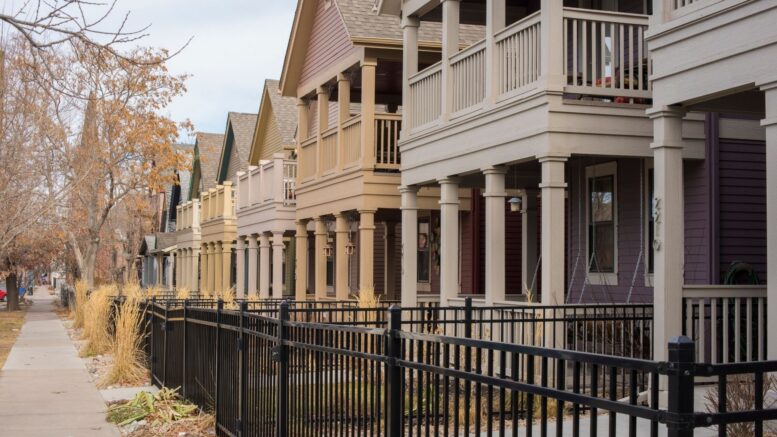Gov. Jared Polis rolled out his long-awaited affordable-housing plan Wednesday — a sweeping proposal that seeks to end some cities’ ability to stop denser housing developments and requires both the state and local governments to conduct regular housing-needs assessments.
The wide-ranging bill at the center of the housing package will run into fierce opposition from the Colorado Municipal League and leaders of some large cities, who will see some of its key provisions as encroaching on their home-rule abilities to regulate how and where things get built within their boundaries. However, it received immediate applause from home builders and from some business organizations that say that overregulation and not-in-my-backyard policies have led in part to the current scarcity of affordable housing, which has contributed to the ongoing labor shortage.
Polis spent a significant amount of time in his State of the State Address in January focused on how Colorado is mired in an affordability crisis and needs to view the housing shortage — estimated by the Common Sense Institute at 117,000 units in 2021 — as a statewide issue. With the soon-to-be-introduced bill, which will be sponsored by Senate Majority Leader Dominick Moreno of Commerce City, the Democratic governor is signaling that he believes boosting the housing supply in and around growth areas should be the priority path forward.

Gov. Jared Polis speaks to a Colorado Chamber of Commerce board meeting earlier this year about his legislative agenda.
To do that, the bill would make major changes to state law that broadly could be put into five separate buckets:
• It would require larger cities to allow multifamily housing to be built along certain corridors, particularly those served by transit lines and featuring commercial and mixed-use development.
• It would establish new rights for landowners in certain cities to be able to build accessory dwelling units and multiplexes up to six units wherever single-family dwellings are an allowed use within existing residential areas.
• It would ban certain municipal policies that limit housing density, including laws requiring minimum square footage for dwellings, restrictions on group living and local bans on manufactured or modular housing.
• It would require Colorado to perform a statewide housing assessment every five years and would mandate that larger local governments submit housing plans addressing how they will seek to meet any shortages of housing needs.
• It would require the state to set strategic-growth objectives that that incentivize housing growth in specific corridors and tie the state’s transportation-planning and natural-resources planning processes to these objectives.
“Local governments that do not allow housing supply to keep pace with household and job growth in their jurisdictions export their housing needs to neighboring communities, causing regional imbalances that impact equity, pollution, infrastructure costs and quality of life,” the bill reads in its legislative declaration. “Requiring local governments to plan for and implement strategies to meet an equitable amount of their region’s housing demand will help mitigate these imbalances and their negative impacts.”
Provisions to boost housing density
The bill aims most of its provisions at municipalities within census urbanized areas with more than 75,000 people that have populations of at least 1,000 residents and at “rural resort job center municipalities” outside of metropolitan planning organizations that have at least 1,000 residents and at least 1,200 jobs. That encompasses large urban centers from Denver to Grand Junction, suburbs from Greenwood Village to Fountain and resort centers from Vail to Glenwood Springs to Telluride.

Key corridors in cities like Denver would be covered by new rules in the proposed affordable-housing bill.
Urban municipalities with fixed-rail transit would be required under the bill to approve multifamily housing as a permitted use at a minimum gross density of 40 acres per unit within a half-mile of light-rail and commuter-rail stations. They could allow bonus density for mixed-income affordable housing and may not require new off-street parking for this housing.
Along “key corridors,” those urban municipalities and rural resort job centers similarly would have to allow multifamily housing as a use by right and may not require new off-street parking, and they would have to establish minimum density standards with increased density allowed for mixed-income affordable projects. Those corridors are defined as: Areas withing a quarter mile of high-frequency bus routes more than one mile in length; commercial and mixed-use corridors and centers; and institutional zones and sites such as schools, religious institutions or governmental partners.
The bill also gives property owners in both of those areas and in some smaller and non-urban municipalities the right to build accessory dwelling units such as mother-in-law lofts, townhomes and multiplexes up to six units as a permitted use in any residential area. The proposal specifically gives municipalities flexibility to regulate short-term rentals or encourage affordability in these housing types — a nod to efforts happening in resort towns — and it bans cities from requiring new off-street parking for all these “middle-housing” types.
Also, the bill would ban urban municipalities from requiring minimum square footage for residential units except in situations where it is required for health and safety, which backers argue increases the cost of housing and reduces its availability. Plus, the bill would stop cities and counties from enforcing residential occupancy limits based on familial relationships and would bar cities and rural resorts from treating the proposed development of modular, manufactured and tiny homes any differently from site-built houses.
Colorado Municipal League Executive Director Kevin Bommer pointed to the wide range of ways that the proposal would insert the state into local policy and said that his initial impression is that it goes way too far in expanding state authority. He added that he would have more to say after having time to review the bill, which is more than 100 pages long, thoroughly.
“CML opposes this sweeping and breathtaking attempt to centralize local land use and zoning policy in the state capitol while doing nothing to guarantee affordability,” Bommer said in a statement to The Sum & Substance. “Drafted in an echo chamber absent any local expertise, the bill was finally shared just last night.”
Wide-ranging support
Polis got kudos from a diverse group of interests, including developers, affordable-housing advocates, environmentalists, representatives for housing-challenged professions like nurses and fire fighters, business organizations and the AARP. Several leaders of county governments, which are exempted from the proposed regulations, also offered endorsement for the plan, and even a spate of city leaders from municipalities such as Boulder, Lakewood and Westminster offered statements Wednesday in favor of it.
“When it comes to talent recruitment and workforce development, Colorado’s limited housing supply and affordability is a growing concern for businesses statewide,” Colorado Chamber of Commerce President/CEO Loren Furman said. “We are in desperate need of new tools and incentives to increase the development of new housing, especially in high-demand areas where employers are looking to attract a diverse collective of workers.”

Loren Furman is president and CEO of the Colorado Chamber of Commerce.
In addition, the bill takes a broader approach to the housing crisis by requiring the state to conduct a housing-needs assessment that examines existing and protected needs by income and household types at the state, local and regional levels. The assessments — which will look at factors like jobs-housing balance and transit accessibility — then will be used by cities to develop their own plans, which must include evaluations of displacement risk in their community and include at least two strategies to increase affordability.
Finally, the bill establishes what its backers call a “north star” to guide state, regional and local entities in developing strategic plans that consider housing objectives in conjunction with transportation, land conservation and other infrastructure needs. Cities required or choosing to update comprehensive plans would have to include in them elements focused on housing, water, agricultural lands and greenfield development.
Interaction with other proposals
Over the next month-and-a-half — the Legislature must adjourn by May 8 — debate will likely focus on the rights of home-rule municipalities versus the purview of the state, as well as the question of whether the proposal is intrusive to local governments in the planning process. Several other major housing bills continue to move through the legislative process — including efforts to give local governments first right of refusal on almost every proposed apartment-complex sale and to allow local governments to enact now-banned rent-control policies — and there will be discussion too on whether they are alternative or complimentary to this plan.
But it’s clear that Polis, who founded and sold multiple businesses, believes that the solution to the affordability crisis must involve a significant increase in the stock of housing available for rent or purchase, as a way of halting price escalation through competition. And it’s also clear that the governor believes that local regulations, particularly around highly traveled corridors, stand in the way of such development now, and that he wants to use the power of the state government to remove those obstacles.
“We applaud Governor Polis’ bold leadership aimed at addressing the state’s housing inventory crisis,” said Nathan Adams, CEO of construction firm redT Homes. “The governor’s plan is smart and will make a real difference, cutting red tape, promoting sustainability and getting the people of this state the housing solutions they so desperately need.”
